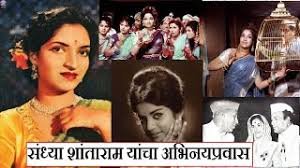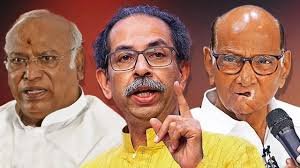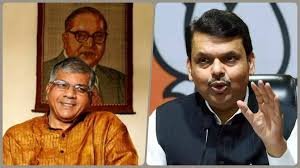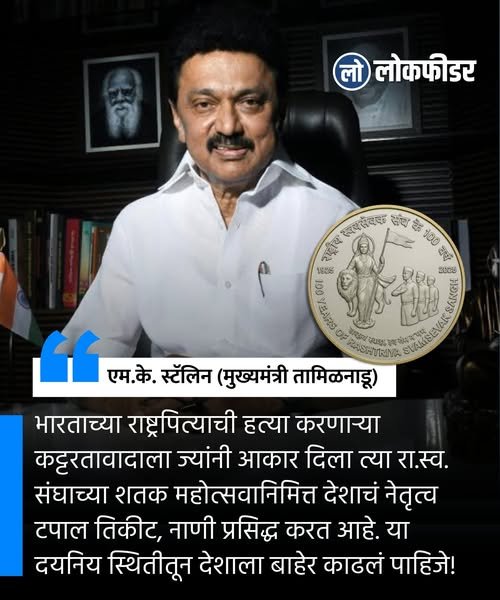
Sandhya Shantaram passes away at 87, films like 'Pinjara' left an indelible mark
Mumbai, October 4, 2025 (Special Correspondent):
The Indian film industry has suffered a big blow today. Famous actress and dancer Sandhya Shantaram passed away today in Mumbai at the age of 87. Her unforgettable roles and dance skills in V. Shantaram's films are still alive in the minds of the audience. Sandhya Tai, who was ill due to old age, passed away this morning in Mumbai. Hearing the news of her death, a wave of grief has spread among many veterans and fans of the film industry.
Sandhya Shantaram, whose original name was Vijaya Deshmukh, was born on September 13, 1938 in Kochi, Kerala. Raised in a loving atmosphere in her family, Sandhya Tai developed a love for music and dance at an early age. However, her life was ordinary before entering the film industry. Her talent was recognized during the casting of V. Shantaram's Marathi film 'Amar Bhupali' in the 1950s. Shantaram Saheb found her voice similar to Jayashree (his second wife and actress) and brought Sandhya Tai into the film industry. She played the role of a singer, Gunavati, in the film 'Amar Bhupali' (1952), which started her film journey. This film was her debut and she went on to play lead roles in many of Shantaram Saheb's films.
Sandhya Tai's married life began in 1956, when she married V. Shantaram. Shantaram Saheb got married to Sandhya Tai after he separated from his second wife Jayashree. This marriage was not just a personal one, but a professional partnership as well. Sandhya Tai's roles were always central in Shantaram Saheb's films. Their pairing gave a new dimension to Indian cinema. Shantaram Saheb passed away in 1990, but Sandhya Tai continued his legacy. She played a significant role in protecting and promoting Rajkamal Studio, which was founded by Shantaram Saheb.
Sandhya Shantaram's career was defined by her dancing and acting skills. She had no formal dance training, but she trained in Kathak dance under the guidance of co-star Gopikrishna for the film 'Jhanak Janak Payal Baje' (1955). In this film, she played the role of Neeladevi, a Kathak dancer who falls in love despite the opposition of her guru. The film was a box office hit and won the National Film Award for 'Best Hindi Film'. It also won four Filmfare Awards. The dance scenes in this film are still considered classics.
Her filmography includes the film 'Teen Batti Char Rasta' (1953), in which she played the role of Shyama/Kokila, a poor girl who is a radio star but has dark skin. For this role, she wore special makeup and tried to look like a cuckoo bird. In 'Do Aankhen Baar Haath' (1958), she played Champa, a toy-selling girl who seduces the prisoners and the warden of the jail. This film was based on a social issue and also won a National Award. In 'Navrang' (1959), she played a double role ΓÇô Jamuna/Mohini ΓÇô in which a beautiful dancer emerges from the poet's imagination. The Holi song "Aare Ja Re Hatt Natkhat" from this film is still popular today, in which she danced with elephants and performed magic tricks wearing a ghungroo.
In 'Stree' (1961), a film based on the story of Shakuntala from the Mahabharata, Sandhya Tai shot scenes with lions, in which no doubles were used. For this, she took training from Singhatarak and practiced in a cage. She played roles like Angara in 'Sehra' (1963), Rani Paigawankar in 'Ladki Sahyadri Ki' (1966), Alka Verma in 'Jal Bin Machili Nritya Bin Bijli' (1971). However, the last major role in her career was as a tamasha artiste in 'Pinjara' (1972), Chandrakala Chandwalkar, who falls in love with a school teacher. This Marathi film was a turning point in her career and was the debut film of Shriram Lagoo. Other films include 'Parchai' (1952), 'Chandanachi Choli Ang Ang Jali' (1975).
Sandhya Tai did not receive many individual awards, but her films won many honours. In 2009, she made a special appearance at the V. Shantaram Awards ceremony on the 50th anniversary of 'Navrang'. After that, her on-screen appearances decreased, but her contribution to the film industry continued.
After Sandhya Tai's death today, her mortal remains were taken from Rajkamal Studios in Mumbai and cremated at Vaikunth Dham Crematorium in Shivaji Park. Family, friends and fans were present at the funeral. Maharashtra's Information Technology and Cultural Affairs Minister Ashish Shelar paid tribute on Instagram. He said, "I am deeply saddened to hear the news of Sandhya Tai's death. Her acting and dance skills left a unique mark on the Marathi-Hindi cinema industry. Her roles in films like 'Jhanak Janak Payal Baje', 'Do Aankhen Barah Haath' and especially 'Pinjara' will never be forgotten. May her soul rest in peace." Tributes are also being paid by other veterans of the film industry. With Sandhya Tai's death, it is being felt that the golden era of the 1950s-70s has come to an end.
Mumbai, October 4, 2025 (Special Correspondent):
The Indian film industry has suffered a big blow today. Famous actress and dancer Sandhya Shantaram passed away today in Mumbai at the age of 87. Her unforgettable roles and dance skills in V. Shantaram's films are still alive in the minds of the audience. Sandhya Tai, who was ill due to old age, passed away this morning in Mumbai. Hearing the news of her death, a wave of grief has spread among many veterans and fans of the film industry.
Sandhya Shantaram, whose original name was Vijaya Deshmukh, was born on September 13, 1938 in Kochi, Kerala. Raised in a loving atmosphere in her family, Sandhya Tai developed a love for music and dance at an early age. However, her life was ordinary before entering the film industry. Her talent was recognized during the casting of V. Shantaram's Marathi film 'Amar Bhupali' in the 1950s. Shantaram Saheb found her voice similar to Jayashree (his second wife and actress) and brought Sandhya Tai into the film industry. She played the role of a singer, Gunavati, in the film 'Amar Bhupali' (1952), which started her film journey. This film was her debut and she went on to play lead roles in many of Shantaram Saheb's films.
Sandhya Tai's married life began in 1956, when she married V. Shantaram. Shantaram Saheb got married to Sandhya Tai after he separated from his second wife Jayashree. This marriage was not just a personal one, but a professional partnership as well. Sandhya Tai's roles were always central in Shantaram Saheb's films. Their pairing gave a new dimension to Indian cinema. Shantaram Saheb passed away in 1990, but Sandhya Tai continued his legacy. She played a significant role in protecting and promoting Rajkamal Studio, which was founded by Shantaram Saheb.
Sandhya Shantaram's career was defined by her dancing and acting skills. She had no formal dance training, but she trained in Kathak dance under the guidance of co-star Gopikrishna for the film 'Jhanak Janak Payal Baje' (1955). In this film, she played the role of Neeladevi, a Kathak dancer who falls in love despite the opposition of her guru. The film was a box office hit and won the National Film Award for 'Best Hindi Film'. It also won four Filmfare Awards. The dance scenes in this film are still considered classics.
Her filmography includes the film 'Teen Batti Char Rasta' (1953), in which she played the role of Shyama/Kokila, a poor girl who is a radio star but has dark skin. For this role, she wore special makeup and tried to look like a cuckoo bird. In 'Do Aankhen Baar Haath' (1958), she played Champa, a toy-selling girl who seduces the prisoners and the warden of the jail. This film was based on a social issue and also won a National Award. In 'Navrang' (1959), she played a double role ΓÇô Jamuna/Mohini ΓÇô in which a beautiful dancer emerges from the poet's imagination. The Holi song "Aare Ja Re Hatt Natkhat" from this film is still popular today, in which she danced with elephants and performed magic tricks wearing a ghungroo.
In 'Stree' (1961), a film based on the story of Shakuntala from the Mahabharata, Sandhya Tai shot scenes with lions, in which no doubles were used. For this, she took training from Singhatarak and practiced in a cage. She played roles like Angara in 'Sehra' (1963), Rani Paigawankar in 'Ladki Sahyadri Ki' (1966), Alka Verma in 'Jal Bin Machili Nritya Bin Bijli' (1971). However, the last major role in her career was as a tamasha artiste in 'Pinjara' (1972), Chandrakala Chandwalkar, who falls in love with a school teacher. This Marathi film was a turning point in her career and was the debut film of Shriram Lagoo. Other films include 'Parchai' (1952), 'Chandanachi Choli Ang Ang Jali' (1975).
Sandhya Tai did not receive many individual awards, but her films won many honours. In 2009, she made a special appearance at the V. Shantaram Awards ceremony on the 50th anniversary of 'Navrang'. After that, her on-screen appearances decreased, but her contribution to the film industry continued.
After Sandhya Tai's death today, her mortal remains were taken from Rajkamal Studios in Mumbai and cremated at Vaikunth Dham Crematorium in Shivaji Park. Family, friends and fans were present at the funeral. Maharashtra's Information Technology and Cultural Affairs Minister Ashish Shelar paid tribute on Instagram. He said, "I am deeply saddened to hear the news of Sandhya Tai's death. Her acting and dance skills left a unique mark on the Marathi-Hindi cinema industry. Her roles in films like 'Jhanak Janak Payal Baje', 'Do Aankhen Barah Haath' and especially 'Pinjara' will never be forgotten. May her soul rest in peace." Tributes are also being paid by other veterans of the film industry. With Sandhya Tai's death, it is being felt that the golden era of the 1950s-70s has come to an end.
The Indian film industry has suffered a big blow today. Famous actress and dancer Sandhya Shantaram passed away today in Mumbai at the age of 87. Her unforgettable roles and dance skills in V. Shantaram's films are still alive in the minds of the audience. Sandhya Tai, who was ill due to old age, passed away this morning in Mumbai. Hearing the news of her death, a wave of grief has spread among many veterans and fans of the film industry.
Sandhya Shantaram, whose original name was Vijaya Deshmukh, was born on September 13, 1938 in Kochi, Kerala. Raised in a loving atmosphere in her family, Sandhya Tai developed a love for music and dance at an early age. However, her life was ordinary before entering the film industry. Her talent was recognized during the casting of V. Shantaram's Marathi film 'Amar Bhupali' in the 1950s. Shantaram Saheb found her voice similar to Jayashree (his second wife and actress) and brought Sandhya Tai into the film industry. She played the role of a singer, Gunavati, in the film 'Amar Bhupali' (1952), which started her film journey. This film was her debut and she went on to play lead roles in many of Shantaram Saheb's films.
Sandhya Tai's married life began in 1956, when she married V. Shantaram. Shantaram Saheb got married to Sandhya Tai after he separated from his second wife Jayashree. This marriage was not just a personal one, but a professional partnership as well. Sandhya Tai's roles were always central in Shantaram Saheb's films. Their pairing gave a new dimension to Indian cinema. Shantaram Saheb passed away in 1990, but Sandhya Tai continued his legacy. She played a significant role in protecting and promoting Rajkamal Studio, which was founded by Shantaram Saheb.
Sandhya Shantaram's career was defined by her dancing and acting skills. She had no formal dance training, but she trained in Kathak dance under the guidance of co-star Gopikrishna for the film 'Jhanak Janak Payal Baje' (1955). In this film, she played the role of Neeladevi, a Kathak dancer who falls in love despite the opposition of her guru. The film was a box office hit and won the National Film Award for 'Best Hindi Film'. It also won four Filmfare Awards. The dance scenes in this film are still considered classics.
Her filmography includes the film 'Teen Batti Char Rasta' (1953), in which she played the role of Shyama/Kokila, a poor girl who is a radio star but has dark skin. For this role, she wore special makeup and tried to look like a cuckoo bird. In 'Do Aankhen Baar Haath' (1958), she played Champa, a toy-selling girl who seduces the prisoners and the warden of the jail. This film was based on a social issue and also won a National Award. In 'Navrang' (1959), she played a double role ΓÇô Jamuna/Mohini ΓÇô in which a beautiful dancer emerges from the poet's imagination. The Holi song "Aare Ja Re Hatt Natkhat" from this film is still popular today, in which she danced with elephants and performed magic tricks wearing a ghungroo.
In 'Stree' (1961), a film based on the story of Shakuntala from the Mahabharata, Sandhya Tai shot scenes with lions, in which no doubles were used. For this, she took training from Singhatarak and practiced in a cage. She played roles like Angara in 'Sehra' (1963), Rani Paigawankar in 'Ladki Sahyadri Ki' (1966), Alka Verma in 'Jal Bin Machili Nritya Bin Bijli' (1971). However, the last major role in her career was as a tamasha artiste in 'Pinjara' (1972), Chandrakala Chandwalkar, who falls in love with a school teacher. This Marathi film was a turning point in her career and was the debut film of Shriram Lagoo. Other films include 'Parchai' (1952), 'Chandanachi Choli Ang Ang Jali' (1975).
Sandhya Tai did not receive many individual awards, but her films won many honours. In 2009, she made a special appearance at the V. Shantaram Awards ceremony on the 50th anniversary of 'Navrang'. After that, her on-screen appearances decreased, but her contribution to the film industry continued.
After Sandhya Tai's death today, her mortal remains were taken from Rajkamal Studios in Mumbai and cremated at Vaikunth Dham Crematorium in Shivaji Park. Family, friends and fans were present at the funeral. Maharashtra's Information Technology and Cultural Affairs Minister Ashish Shelar paid tribute on Instagram. He said, "I am deeply saddened to hear the news of Sandhya Tai's death. Her acting and dance skills left a unique mark on the Marathi-Hindi cinema industry. Her roles in films like 'Jhanak Janak Payal Baje', 'Do Aankhen Barah Haath' and especially 'Pinjara' will never be forgotten. May her soul rest in peace." Tributes are also being paid by other veterans of the film industry. With Sandhya Tai's death, it is being felt that the golden era of the 1950s-70s has come to an end.

.jpg)
















